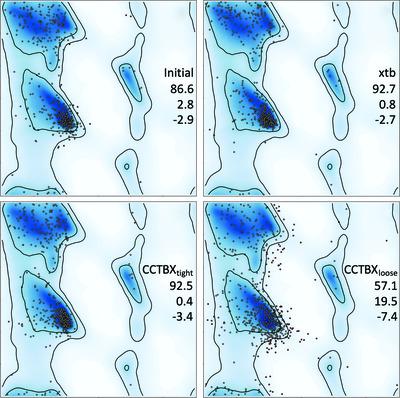当前位置:
X-MOL 学术
›
Acta Cryst. D
›
论文详情
Our official English website, www.x-mol.net, welcomes your feedback! (Note: you will need to create a separate account there.)
Real‐space quantum‐based refinement for cryo‐EM: Q|R#3
Acta Crystallographica Section D ( IF 2.2 ) Pub Date : 2020-12-02 , DOI: 10.1107/s2059798320013194 Lum Wang 1 , Holger Kruse 2 , Oleg V Sobolev 3 , Nigel W Moriarty 3 , Mark P Waller 4 , Pavel V Afonine 3 , Malgorzata Biczysko 1
Acta Crystallographica Section D ( IF 2.2 ) Pub Date : 2020-12-02 , DOI: 10.1107/s2059798320013194 Lum Wang 1 , Holger Kruse 2 , Oleg V Sobolev 3 , Nigel W Moriarty 3 , Mark P Waller 4 , Pavel V Afonine 3 , Malgorzata Biczysko 1
Affiliation

|
Electron cryo‐microscopy (cryo‐EM) is rapidly becoming a major competitor to X‐ray crystallography, especially for large structures that are difficult or impossible to crystallize. While recent spectacular technological improvements have led to significantly higher resolution three‐dimensional reconstructions, the average quality of cryo‐EM maps is still at the low‐resolution end of the range compared with crystallography. A long‐standing challenge for atomic model refinement has been the production of stereochemically meaningful models for this resolution regime. Here, it is demonstrated that including accurate model geometry restraints derived from ab initio quantum‐chemical calculations (HF‐D3/6‐31G) can improve the refinement of an example structure (chain A of PDB entry 3j63). The robustness of the procedure is tested for additional structures with up to 7000 atoms (PDB entry 3a5x and chain C of PDB entry 5fn5) using the less expensive semi‐empirical (GFN1‐xTB) model. The necessary algorithms enabling real‐space quantum refinement have been implemented in the latest version of qr.refine and are described here.
中文翻译:

基于实空间量子的冷冻电镜精修:Q|R#3
电子冷冻显微镜 (cryo-EM) 正迅速成为 X 射线晶体学的主要竞争对手,尤其是对于难以或不可能结晶的大型结构。虽然最近的技术进步显着提高了三维重建的分辨率,但与晶体学相比,冷冻电镜图的平均质量仍处于低分辨率范围的一端。原子模型细化的一个长期挑战是为该分辨率体系生成具有立体化学意义的模型。在这里,证明包括从ab initio量子化学计算 (HF-D3/6-31G)导出的精确模型几何约束可以改进示例结构(链APDB 条目 3j63)。使用较便宜的半经验模型 (GFN1-xTB)测试了该过程的稳健性,用于多达 7000 个原子的附加结构(PDB 条目 3a5x 和 PDB 条目 5fn5 的链C)。最新版本的qr.refine已经实现了实现真实空间量子精化的必要算法,并在此处进行了描述。
更新日期:2020-12-02
中文翻译:

基于实空间量子的冷冻电镜精修:Q|R#3
电子冷冻显微镜 (cryo-EM) 正迅速成为 X 射线晶体学的主要竞争对手,尤其是对于难以或不可能结晶的大型结构。虽然最近的技术进步显着提高了三维重建的分辨率,但与晶体学相比,冷冻电镜图的平均质量仍处于低分辨率范围的一端。原子模型细化的一个长期挑战是为该分辨率体系生成具有立体化学意义的模型。在这里,证明包括从ab initio量子化学计算 (HF-D3/6-31G)导出的精确模型几何约束可以改进示例结构(链APDB 条目 3j63)。使用较便宜的半经验模型 (GFN1-xTB)测试了该过程的稳健性,用于多达 7000 个原子的附加结构(PDB 条目 3a5x 和 PDB 条目 5fn5 的链C)。最新版本的qr.refine已经实现了实现真实空间量子精化的必要算法,并在此处进行了描述。


























 京公网安备 11010802027423号
京公网安备 11010802027423号